
The Pale or the English Pale was the part of Ireland directly under the control of the English government in the Late Middle Ages. It had been reduced by the late 15th century to an area along the east coast stretching from Dalkey, south of Dublin, to the garrison town of Dundalk. The inland boundary went to Naas and Leixlip around the Earldom of Kildare, towards Trim and north towards Kells. In this district, many townlands have English or French names, the latter associated with Norman influence in England.
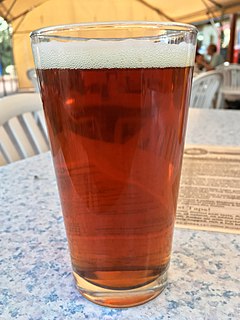
Pale ale is a typically golden to amber coloured style of ale which is brewed using an ale yeast and predominantly pale malt. The term first appeared around 1703 for beers made from malts dried with high-carbon coke, which resulted in a lighter colour than other beers popular at that time. Different brewing practices and hop quantities have resulted in a range of tastes and strengths within the pale ale family.
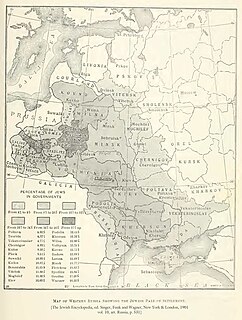
The Pale of Settlement was a western region of the Russian Empire with varying borders that existed from 1791 to 1917 in which permanent residency by Jews was allowed and beyond which Jewish residency, permanent or temporary, was mostly forbidden. Most Jews were still excluded from residency in a number of cities within the Pale as well. A few Jews were allowed to live outside the area, including those with university education, the ennobled, members of the most affluent of the merchant guilds and particular artisans, some military personnel and some services associated with them, including their families, and sometimes their servants. The archaic English term pale is derived from the Latin word palus, a stake, extended to mean the area enclosed by a fence or boundary.

The Tudor conquestof Ireland took place under the Tudor dynasty, which held the Kingdom of England during the 16th century. Following a failed rebellion against the crown by Silken Thomas, the Earl of Kildare, in the 1530s, Henry VIII was declared King of Ireland in 1542 by statute of the Parliament of Ireland, with the aim of restoring such central authority as had been lost throughout the country during the previous two centuries. Several people who helped establish the Plantations of Ireland also played a part later in the early colonisation of North America, particularly a group known as the West Country men.

From the 12th century onwards, a group of Normans invaded and settled in Gaelic Ireland. These settlers later became known as Norman Irish or Hiberno-Normans. They originated mainly among Cambro-Norman families in Wales and Anglo-Normans from England, who were loyal to the Kingdom of England, and the English state supported their claims to territory in the various realms then comprising Ireland. During the High Middle Ages and Late Middle Ages the Hiberno-Normans constituted a feudal aristocracy and merchant oligarchy, known as the Lordship of Ireland. In Ireland, the Normans were also closely associated with the Gregorian Reform of the Catholic Church in Ireland. Over time the descendants of the 12th-century Norman settlers spread throughout Ireland and around the world, as part of the Irish diaspora; they ceased, in most cases, to identify as Norman, Cambro-Norman or Anglo-Norman.

The brown hairstreak is a butterfly in the family Lycaenidae. The range includes most of the Palaearctic.

CAIN is a database containing information about Conflict and Politics in Northern Ireland from 1968 to the present. The project began in 1996, with the website launching in 1997. The project is based within Ulster University at its Magee campus. The archive chronicles important events during the Troubles, stretching from 1968 until the present day. The name is an allusion to the Biblical Cain, who murdered his brother Abel.
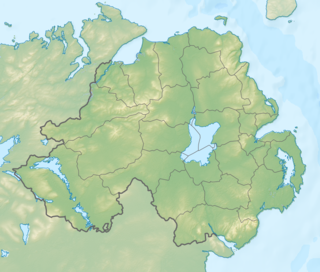
The Droppin Well bombing or Ballykelly bombing occurred on 6 December 1982, when the Irish National Liberation Army (INLA) exploded a time bomb at a disco in Ballykelly, Northern Ireland. The disco, known as the Droppin Well, was targeted because it was frequented by British Army soldiers from nearby Shackleton Barracks. The bomb killed eleven soldiers and six civilians; 30 people were injured, this made it the most deadly attack during the INLA's paramilitary campaign and the most deadly attack during The Troubles carried out in County Londonderry.
Beyond the Pale may refer to:
William John Twaddell was a Unionist politician from Belfast.

Patrick Clarke is a writer, director, producer and actor. Clarke co-wrote and produced his first feature Beyond the Pale in 1999. Based on actual events, the immigrant drama was a commercial success in Ireland, Australia and the UK and won awards at the Houston and Arizona film festivals (2000). Clarke's performance in Beyond the Pale led to roles in The Magnificent Ambersons for A&E Networks and the award-winning black comedy Stay Until Tomorrow (2004), which was developed through the Sundance Institute.
Events from the year 1779 in Ireland.

The Sprawler(Asteroscopus sphinx) is a moth of the family Noctuoidea. It is found throughout western Europe, but is mainly a Northern species occurring South to Northern Spain the southern edge of the Alps, Central Italy and Northern Greece. North to southern Sweden. East to Kaliningrad and Moscow. Also in Central Europe, Turkey, the Caucasus and Asia Minor.

Lacanobia contigua, the beautiful brocade, is a moth of the family Noctuidae. The species was first described by Michael Denis and Ignaz Schiffermüller in 1775. It is found throughout temperate regions of the Palearctic realm, from Ireland east to Siberia and Japan.
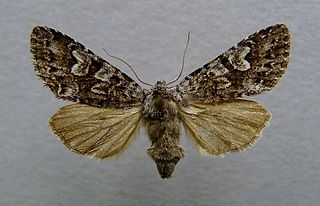
Papestra biren, the glaucous shears, is a moth of the family Noctuidae. The species was first described by Johann August Ephraim Goeze in 1781. It is found in most of Europe, but not in the southern parts of the Iberian Peninsula, Italy and Greece. Outside of Europe it is found in Kashmir and through the Palearctic to Siberia, Central Asia, Amur, Kamchatka, the Russian Far East and Japan. It was introduced in Newfoundland in 1935 and has since then extended its range ever more southward within North America partly overlapping with Papestra quadrata(Smith, 1891). It rises to 2200 m above sea level in the Alps.
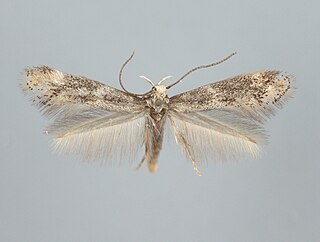
Elachista canapennella is a moth of the family Elachistidae found in Europe.

Stigmella floslactella is a moth of the family Nepticulidae. It is found in all of Europe, except the Balkan Peninsula and the Mediterranean islands.
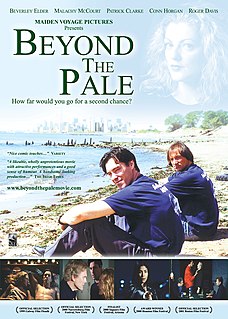
Beyond the Pale is a 1999 immigrant drama set in mid-1980s New York, directed by George Bazala and starring Patrick Clarke, Malachy McCourt and Roger Davis.

Scrobipalpa instabilella, the saltern groundling, is a moth in the family Gelechiidae. It was described by John William Douglas in 1846. It is found in on the Canary Islands, in Algeria, Ireland, Great Britain, Portugal, Spain, France, Belgium, the Netherlands, Germany, Denmark, Italy, Sardinia, Sicily, Greece, Cyprus and Palestine. It is also present in the United States, where it has been recorded from California.















